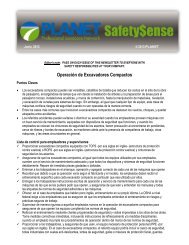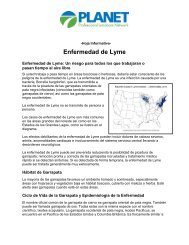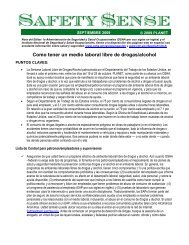Economic Impacts of the Green Industry in the - Urban Forest ...
Economic Impacts of the Green Industry in the - Urban Forest ...
Economic Impacts of the Green Industry in the - Urban Forest ...
Create successful ePaper yourself
Turn your PDF publications into a flip-book with our unique Google optimized e-Paper software.
An important reason that nursery crop sales rema<strong>in</strong>ed healthy <strong>in</strong> 2003, compared with floriculture crops, is <strong>the</strong><br />
lower share <strong>of</strong> imports <strong>in</strong> nursery crop consumption. Relentless competition from imported cut flowers from<br />
South America has reduced domestic growers’ U.S. market share to m<strong>in</strong>ority status. Per-household consumption<br />
<strong>of</strong> greenhouse and nursery crops <strong>of</strong> $139 <strong>in</strong> 2004 represents <strong>the</strong> second year <strong>of</strong> decl<strong>in</strong>e s<strong>in</strong>ce its peak <strong>in</strong> 2002,<br />
match<strong>in</strong>g <strong>the</strong> pattern <strong>of</strong> floriculture crops. Never<strong>the</strong>less, <strong>the</strong> ornamental crop sector will post total sales <strong>in</strong> excess<br />
<strong>of</strong> $15.3 billion <strong>in</strong> 2004, a value exceeded only by corn, soybeans, and vegetables among agricultural crops<br />
nationwide.<br />
Sales <strong>of</strong> floriculture crops were projected to grow to $5.1 billion <strong>in</strong> 2004, due largely to ga<strong>in</strong>s from bedd<strong>in</strong>g and<br />
garden plants which represent 48 percent <strong>of</strong> total floriculture sales. Sales <strong>of</strong> bedd<strong>in</strong>g and garden annuals and<br />
herbaceous perennials are forecast to <strong>in</strong>crease 1 percent. This contrasts with decl<strong>in</strong>es <strong>in</strong> cut flowers, potted<br />
flower<strong>in</strong>g and foliage plants, and cut cultivated greens as compet<strong>in</strong>g imports provide fur<strong>the</strong>r <strong>in</strong>centives for<br />
growers to produce o<strong>the</strong>r higher value and specialty crops. However, outsourc<strong>in</strong>g cutt<strong>in</strong>gs and seedl<strong>in</strong>g<br />
production to lower-cost growers <strong>in</strong> Central America and Mexico is one way that domestic producers are cop<strong>in</strong>g.<br />
Besides <strong>the</strong> top three producers <strong>of</strong> ornamental crops—California, Florida, and Texas—North Carol<strong>in</strong>a and<br />
Oregon are close to reach<strong>in</strong>g $1 billion <strong>in</strong> annual sales. Both <strong>of</strong> <strong>the</strong>se States produce about $800 million worth <strong>of</strong><br />
nursery and o<strong>the</strong>r greenhouse crops and only between $100 and $200 million <strong>of</strong> floriculture crops. Emerg<strong>in</strong>g<br />
competitors are Michigan and Ohio, which, by contrast, produced between $200 and $400 million <strong>of</strong> floriculture<br />
crops <strong>in</strong> 2003. These Midwestern States are lead<strong>in</strong>g producers <strong>of</strong> bedd<strong>in</strong>g and garden plants, both annuals and<br />
perennials, <strong>in</strong> large part due to <strong>in</strong>creased greenhouse production. Michigan and Ohio are not far beh<strong>in</strong>d Texas <strong>in</strong><br />
total greenhouse acreage. While Florida rema<strong>in</strong>s <strong>the</strong> predom<strong>in</strong>ant supplier <strong>of</strong> <strong>in</strong>door foliage plants east <strong>of</strong> <strong>the</strong><br />
Mississippi River, upcom<strong>in</strong>g suppliers <strong>in</strong>clude North Carol<strong>in</strong>a, Ohio, and Louisiana.<br />
Toge<strong>the</strong>r with bedd<strong>in</strong>g and garden plants, nursery and o<strong>the</strong>r greenhouse crops are <strong>the</strong> only agricultural product<br />
groups expected to cont<strong>in</strong>ue ga<strong>in</strong>s <strong>in</strong> per-U.S.-household sales. Their higher sales <strong>in</strong> 2004 more than <strong>of</strong>fset <strong>the</strong><br />
decl<strong>in</strong>es <strong>in</strong> <strong>the</strong> o<strong>the</strong>r groups. Includ<strong>in</strong>g Christmas trees, greenhouse vegetables, vegetable transplants, and sod,<br />
sales <strong>of</strong> nursery and o<strong>the</strong>r greenhouse crops have cont<strong>in</strong>uously grown historically but have slowed <strong>in</strong> recent years<br />
<strong>in</strong> terms <strong>of</strong> per-U.S.-household sales at around $93 s<strong>in</strong>ce 2002. Given that this sector accounts for two-thirds <strong>of</strong><br />
total greenhouse and nursery crop receipts, it is largely responsible for keep<strong>in</strong>g per-household sales <strong>of</strong><br />
ornamentals and o<strong>the</strong>r greenhouse crops at about $139 <strong>in</strong> recent years.<br />
While <strong>the</strong> projected <strong>in</strong>crease <strong>in</strong> floriculture growers’ sales <strong>in</strong> 2004 is modest, average annual sales per grower is<br />
expected to cont<strong>in</strong>ue ris<strong>in</strong>g beyond $1 million. As grower sales expand, ei<strong>the</strong>r total production area also expands<br />
or sales per acre <strong>in</strong>creases. In 2003, total U.S. floriculture production area <strong>in</strong>creased largely due to Texas add<strong>in</strong>g<br />
10 times more space <strong>of</strong> open field production. Despite growth <strong>in</strong> open field production, average covered<br />
production area per large grower rose 3 percent to 4 acres, up from 3.9 <strong>in</strong> 2002. After climb<strong>in</strong>g <strong>in</strong> 2002, <strong>the</strong><br />
number <strong>of</strong> growers with at least $100,000 <strong>in</strong> annual floriculture sales fell from 4,974 to 4,741 <strong>in</strong> 2003. The<br />
addition <strong>of</strong> significant open field production area by growers pushed total production acres to 57,507 acres <strong>in</strong><br />
2003, up from 52,235 <strong>in</strong> 2002. However, s<strong>in</strong>ce total production acreage grew faster than floriculture sales,<br />
average sales per acre dropped 9 percent, from $91,000 to $83,000, <strong>in</strong> 2003. Floriculture sales per production acre<br />
are still highest <strong>in</strong> <strong>the</strong> Midwestern States at $126,000. Growers <strong>in</strong> M<strong>in</strong>nesota lead <strong>the</strong> region at almost $230,000<br />
sales per acre. Never<strong>the</strong>less, <strong>the</strong> largest growers based on floral sales are <strong>in</strong> <strong>the</strong> West—average sales per grower<br />
<strong>in</strong> California now exceed $1.8 million. While Sou<strong>the</strong>rn States trail <strong>the</strong> West at $1.1 million sales, average sales<br />
per grower <strong>in</strong> South Carol<strong>in</strong>a tops <strong>the</strong> country at $2.5 million sales per grower, dwarf<strong>in</strong>g California’s average.<br />
South Carol<strong>in</strong>a is <strong>the</strong> biggest producer <strong>of</strong> herbaceous perennial plants, sell<strong>in</strong>g 12 percent <strong>of</strong> total U.S. production.<br />
After slipp<strong>in</strong>g <strong>in</strong> 2002, U.S. cut flower imports surged 13 percent to $611 million <strong>in</strong> 2003, and are expected to<br />
cont<strong>in</strong>ue to grow <strong>in</strong> 2004 (USDA, NASS). As a result, sales <strong>of</strong> domestically produced U.S. cut flowers are<br />
forecast down 1 percent <strong>in</strong> 2004, but consumer prices for flowers and <strong>in</strong>door plants are up 18 percent from 2003.<br />
Cut flower production <strong>in</strong> California, which accounts for 70 percent <strong>of</strong> U.S. production, is at best flat <strong>in</strong> 2004, even<br />
<strong>in</strong> view <strong>of</strong> higher prices. The projected decl<strong>in</strong>e <strong>in</strong> volume <strong>of</strong> domestic cut flowers sold <strong>in</strong> 2004 is cushioned to<br />
some extent by somewhat higher prices. Overall sales <strong>of</strong> $421 million <strong>in</strong> 2004 are down 1 percent from 2003. As<br />
a result, sales per U.S. household fell to $3.83, almost a whole dollar lower than <strong>in</strong> 1997. By contrast, cut flower<br />
imports per U.S. household are almost $6, match<strong>in</strong>g 1998’s level. Cut flowers comprise half <strong>of</strong> total U.S.<br />
11
















